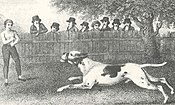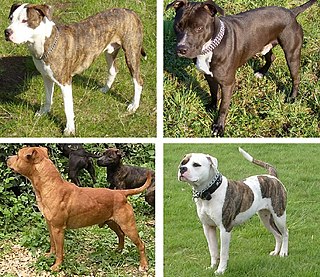
Pit bull is an umbrella term for several types of dog believed to have descended from bull and terriers. In the United States, the term is usually considered to include the American Pit Bull Terrier, American Staffordshire Terrier, American Bully, Staffordshire Bull Terrier, and sometimes the American Bulldog, along with any crossbred dog that shares certain physical characteristics with these breeds. In other countries, including the United Kingdom, the term is used as an abbreviation of the American Pit Bull Terrier breed specifically, while the Staffordshire Bull Terrier is not considered a pit bull. Most pit bull-type dogs descend from the British bull and terrier, a 19th-century dog-fighting type developed from crosses between the Old English Bulldog and the Old English Terrier.

The Bulldog is a British breed of dog of mastiff type. It may also be known as the English Bulldog or British Bulldog. It is a medium-sized, muscular dog of around 40–55 lb (18–25 kg). They have large heads with thick folds of skin around the face and shoulders and a relatively flat face with a protruding lower jaw. The breed has significant health issues as a consequence of breeding for its distinctive appearance, including brachycephaly, hip dysplasia, heat sensitivity, and skin infections. Due to concerns about their quality of life, breeding Bulldogs is illegal in Norway and the Netherlands.

The Staffordshire Bull Terrier, also called the Staffy or Stafford, is a purebred dog of small to medium size in the terrier group that originated in the northern parts of Birmingham and in the Black Country of Staffordshire, for which it is named. They descended from 19th-century bull terriers that were developed by crossing bulldogs with various terriers to create a generic type of dog generally known as bull and terriers. Staffords share the same ancestry with the modern Bull Terrier, although the two breeds developed along independent lines, and do not resemble each other. Modern Staffords more closely resemble the old type of bull terrier, and were first recognised as a purebred dog breed by The Kennel Club of Great Britain in 1935.

Bull-baiting is a blood sport involving pitting a bull against dogs with the aim of attacking and subduing the bull by biting and holding onto its nose or neck, which often resulted in the death of the bull.
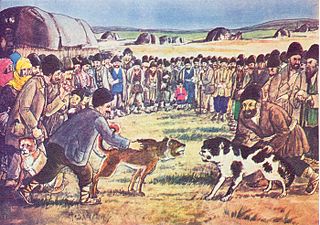
Dog fighting is a type of blood sport that turns game and fighting dogs against each other in a physical fight, often to the death, for the purposes of gambling or entertainment to the spectators. In rural areas, fights are often staged in barns or outdoor pits; in urban areas, fights are often staged in garages, basements, warehouses, alleyways, abandoned buildings, neighborhood playgrounds, or in the streets. Dog fights usually last until one dog is declared a winner, which occurs when one dog fails to scratch, dies, or jumps out of the pit. Sometimes dog fights end without declaring a winner; for instance, the dog's owner may call the fight.

The American bulldog is a large, muscular breed of mastiff-type dog. Their ancestors were brought to the British North American colonies where they worked on small farms and ranches.

The Olde English Bulldogge is an American dog breed, recognized by the United Kennel Club (UKC) in January 2014. The breed is listed in the UKC Guardian Dog Group. Five years prior to UKC recognition, the breed was registered by the former Canine Developmental, Health and Performance Registry (CDHPR), a privately held business located in Kalamazoo, Michigan. In the early 2000s, CDHPR had been working with the UKC under a unique agreement to develop breeding plans and strategies in an effort to produce improved breeds of dogs that would be accepted as purebred and, therefore, eligible for UKC registration.

The Old English Bulldog is an extinct breed of dog.

Bulldogs are a type of dog that were traditionally used for the blood sports of baiting and dog fighting, but today are kept for other purposes, including companion dogs, guard dogs and catch dogs. Bulldogs are typically stocky, powerful, square-built animals with large, strong, brachycephalic-type muzzles. "Bull" is a reference that originated in England that refers to the sport of bull baiting, which was a national sport in England between the 13th and 18th century. It is believed bulldogs were developed during the 16th century in the Elizabethan era from the larger mastiffs, as smaller, more compact dogs were better suited for baiting.

Rat-baiting is a blood sport that involves releasing captured rats in an enclosed space with spectators betting on how long a dog, usually a terrier, takes to kill the rats. Often, two dogs competed, with the winner receiving a cash prize. It is now illegal in most countries.

Lion-baiting is a blood sport involving the baiting of lions against dogs.

Bull and terrier was a common name for crossbreeds between bulldogs and terriers in the early 1800s. Other names included half-and-halfs and half-breds. It was a time in history when, for thousands of years, dogs were classified by use or function, unlike the modern pets of today that were bred to be conformation show dogs and family pets. Bull and terrier crosses were originally bred to function as fighting dogs for bull- and bear-baiting, and other popular blood sports during the Victorian era. The sport of bull baiting required a dog with attributes such as tenacity and courage, a wide frame with heavy bone, and a muscular, protruding jaw. By crossing bulldogs with various terriers from Ireland and Great Britain, breeders introduced "gameness and agility" into the hybrid mix.
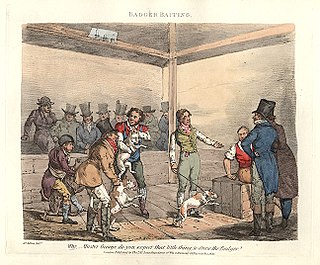
Badger-baiting is a form of blood sport in which badgers are baited with dogs. A baiting session typically results in the death of the badger, and possibly serious injuries to the dogs.

Monkey-baiting is a blood sport involving the baiting of monkeys against dogs.
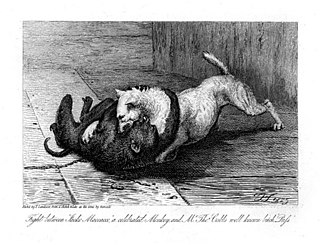
Jacco Macacco was a fighting ape or monkey who was exhibited in monkey-baiting matches at the Westminster Pit in London in the early 1820s. He achieved some measure of fame among the sporting community through his reputed prodigious record of victories against dogs, but was brought to wider attention by depiction in popular literature, artworks and by citation in speeches to Parliament by the animal welfare campaigner Richard Martin. Jacco's most famous fight, against the equally well-known bitch Puss, seems to have marked the end of his career: he may have died as a result of injuries received during the match or of an unrelated illness sometime afterwards. His ashes are claimed to be housed at the True Crime Museum in Hastings, East Sussex.

The Dogo Cubano, also called the Cuban Bloodhound or Cuban Bullmastiff, is an extinct Cuban breed of domestic dog. It was of the dogo sub-type of the bullmastiff dog type, which as a general class was used for bull-baiting and dog fighting. The variety was introduced in Cuba to capture runaway slaves. After the abolition of slavery, they ceased to exist as a distinct population over time.
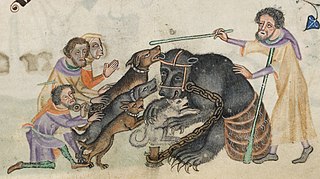
Bear-baiting is a blood sport in which a chained bear and one or more dogs are forced to fight one another. It may also involve pitting a bear against another animal. Until the 19th century, it was commonly performed in Great Britain, Sweden, India, Pakistan, and Mexico among others.
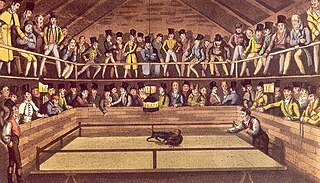
The Westminster Pit was a well-known blood sport arena in nineteenth-century London, England. It reached a zenith of popularity between 1820 and 1830, and hosted such spectacles as dog-fighting, cock-fighting, bear-baiting, badger-baiting, monkey-baiting, and rat-baiting. A legal enterprise at the time, the Westminster Pit openly declared its activities, ushering notoriety on the district in which it existed.

The Gull Terrier is a rare breed of dog that originates from the Punjab region of Pakistan and India; it is believed to be several hundred years old. They are often used in dog fighting, hunting, and guarding. The Gull Terrier is a direct decendent of the Bull Terrier breed that came from Great Britain. These English dog breeds, along with those indigenous to the Indian subcontinent such as the Bully Kutta, played a major role in the Gull Terrier's breeding development and are considered to be a direct ancestor of the modern Gull Terrier. Old photographs of the English Bull terrier delineate many of the same features such as height pointy ears and a long muzzle of the Gull Terrier.
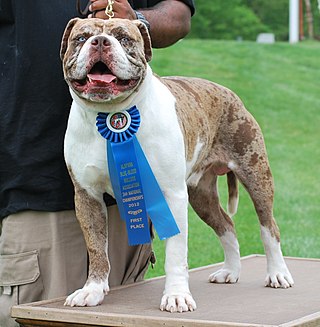
The Alapaha Blue Blood Bulldog is a breed of bulldog from the United States, and it is predominantly used as a guard dog. It is a very powerful, muscular breed with large head and brachycephalic muzzle. The hair coat is short, typically colored white with black, blue, buff or brown patches, and its tail is kept un-docked. Sexual dimorphism is common in the breed, with larger dogs typically twice the weight of smaller bitches.
